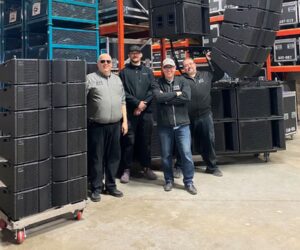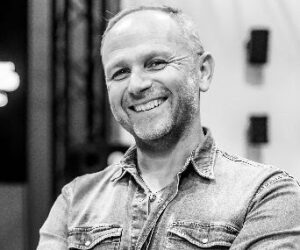Some people have an innate ability to leave indelible marks on others. Whether due to their personality, brilliance or the way they care for people, they’re people you don’t forget meeting. Such was the case with Bob Heil. He left this mortal coil in late February, but not before leaving a legacy that changed several industries and more than a few people.
I met Bob for the first time back in 2011 or so. I’d not heard of him prior to that, but in 2010, I got a call from Greg McVeigh, Heil Sound’s artist relations person, asking if I’d like to take a look at some of their microphones. Being somewhat mic curious, I said of course. Greg dropped off a then-new RC 35 wireless capsule, which I promptly put to work and was hooked. I don’t think it took that long before I had the full complement of Heil mics in my locker.
Sometime that fall, I was relaxing at home on a day off and my phone rang. I didn’t recognize the number, but for some reason answered it anyway. Much to my surprise, it was Bob. At the time, my website was just taking off, and he was calling to talk sound and to encourage me to keep writing and teaching. “You’re doing some great work, Mike! I really hope you keep it up because we need people like you.” We had a great chat, the first of many.
It was NAMM 2011 when I was able to meet him in person, and was immediately impressed by his passion, energy and enthusiasm. By my math, he was 70 at the time, and had way more energy after three days of a massive trade show than I did 30 years his junior. As became our custom, we talked for nearly an hour.
Early Days
Bob grew up in the St. Louis area, and by age 15 was the house player of the Wurlitzer theater organ at the Fox Theater in St. Louis. He learned not only to play, but also to tune the thousands of pipes in the big organs, a skill that taught him to really listen to sound. As a teen, he was also an avid ham radio operator. I remember him telling me once, “People ask, ‘What does ham radio have to do with sound?’ Well it has everything to do with it! It’s all about phase!” Those early years of pipe organs and ham radio set the stage for a very colorful and legendary career in live sound.
In the late 1960s, Bob was running his Ye Olde Music Shop in Marissa, IL, and happened by the Fox Theater when they were replacing the venue’s loudspeakers. The person doing the work was taking them out back to the trash and Bob asked if he could have them, to which the answer was yes. He took the Altec Lansing A-4 cabinets, replaced the drivers and added four radial horns and ring tweeters. This was one of the first iterations of hi-fi type large-format PA systems that we take for granted today. The horns added the clarity necessary so the vocals could be clearly heard; clarity is another of Bob’s watchwords.
In addition to the loudspeakers, Bob and his friend Tomlinson Holman (the “TH” in THX) re-wired a Langevin recording console to make it more suitable for live work. Bob created a crossover to control the loudspeaker outputs, and he would also tape a small mic to the rear of vocal mics, but ran them out of phase so anything that leaked into the vocal mics from the monitors would be canceled. That allowed them to get monitors crazy loud. It really is all about phase.
The system got the attention of a few up-and-coming bands, notably the Grateful Dead and The Who. While working with the Dead, it was Jerry Garcia who suggested to Bob that he name his company after himself, because no one would be able to remember Ye Olde Music Shop. Heil Sound was born. After wrapping up the Dead tour, Bob went on to do Who’s Next, and ultimately, he was commissioned to create the PA for the Quadrophenia tour. He then went on to create the Heil Talk Box, which was famously used by Peter Frampton, Joe Walsh and Richie Sambora.
Sharing The Passion
While Bob possessed an impressive knowledge of the physics of sound, a passion for phase coherency and a strong belief that dynamic mics were better than condenser mics for live sound, what really impressed me every time we met at a show was this: when you were talking with Bob, you were the most important person in the room. He freely shared his knowledge and passion for great sound, and did it in a way that left you both encouraged and exhausted from the knowledge dump.
A short while after I moved to Nashville, I received a call from Greg saying Bob and the crew were coming down and wondered if I wanted to grab breakfast. One does not turn down such an invite. Shortly before the appointed date, I happened to be watching the Netflix documentary on the band Kansas. I caught a still shot of the band in the studio in front of a purple audio mixer. I knew immediately that it was a Heil Sound mixer and asked Bob about it at breakfast.
“There’s a story behind that mixer, you want to hear it?” Of course, that’s why I asked! Apparently, the band had heard about Bob’s great-sounding mixers and decided they had to have one. After doing a show somewhere – I believe in the state of Kansas – they drove their converted school bus through the night and arrived at Heil Sound in the wee hours of the morning. They parked out front and waited for Bob to arrive in the morning.
He thought it was crazy to drive all that way, especially in a school bus that he noted did not appear to have a shower. But he got them a console and sent them on their way.
I was privileged to have a good number of conversations with Bob over the years, and I can truly say he was instrumental in forming and changing the way I think about things like PA design, drum and organ miking. Once I asked him about the best way to mic a Leslie 122; he told me, I tried it and I’ve not changed since. It was truly that much better than what I was doing.
The list of Bob’s professional accomplishments is far too long to list in this article. His life is a terrific example of what someone can do when driven by passion and an insatiable desire to learn. I left every conversation with Bob fired up and encouraged to try something else new. He had that effect on people. When an industry legend dies, it’s often stated that that industry suffered a loss. In Bob’s case, not only has pro audio lost a legend, so has ham radio, and the theater organ world.
Bob will be missed, but I know he would want us all to press on, learning, experimenting and most of all, keeping it in phase.















